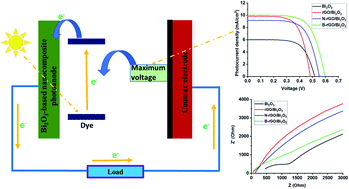Synthesis and characterisation of heteroatom-doped reduced graphene oxide/bismuth oxide nanocomposites and their application as photoanodes in DSSCs†
Abstract
Semiconductor materials have been recently employed in photovoltaic devices, particularly dye-sensitized solar cells (DSSCs), to solve numerous global issues, especially the current energy crisis emanating from the depletion and hazardous nature of conventional energy sources, such as fossil fuels and nuclear energy. However, progress for the past years has been mainly limited by poor electron injection and charge carrier recombination experienced by DSSCs at the photoanode. Thus, novel semiconductor materials such as bismuth oxide (Bi2O3) have been investigated as an alternative photoanode material. In this study, Bi2O3 was integrated with nitrogen- or boron-doped reduced graphene oxide (N-rGO or B-rGO, respectively) via a hydrothermal approach at a temperature of 200 °C. Various instrumental techniques were used to investigate the morphology, phase structure, thermal stability, and surface area of the resulting nanocomposites. The incorporation of N-rGO or B-rGO into Bi2O3 influenced the morphology and structure of the nanocomposite, thereby affecting the conductivity and electrochemical properties of the nanocomposite. B-rGO/Bi2O3 exhibited a relatively large surface area (65.5 m2 g−1), lower charge transfer resistance (108.4 Ω), higher charge carrier mobility (0.368 cm2 V−1 s−1), and higher electrical conductivity (6.31 S cm−1) than N-rGO/Bi2O3. This led to the fabrication of B-rGO/Bi2O3 photoanode-based DSSCs with superior photovoltaic performance, as revealed by their relatively high power conversion efficiency (PCE) of 2.97%, which outperformed the devices based on N-rGO/Bi2O3, rGO/Bi2O3, and Bi2O3 photoanodes. Therefore, these results demonstrate the promising potential of heteroatom-doped rGO/Bi2O3-based nanocomposites as photoanode materials of choice for future DSSCs.



 Please wait while we load your content...
Please wait while we load your content...